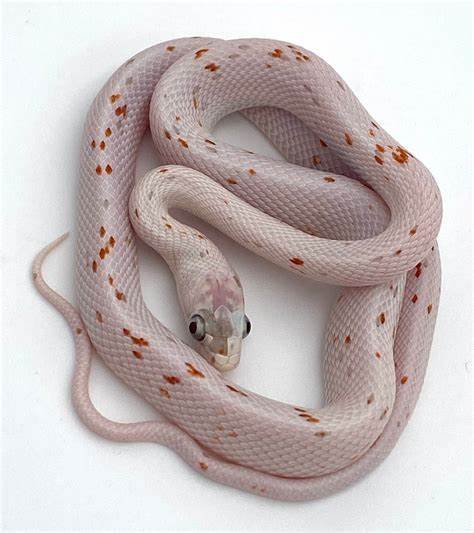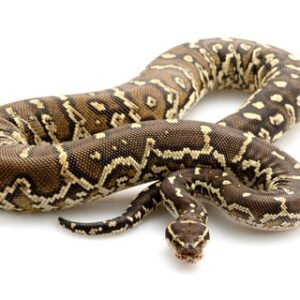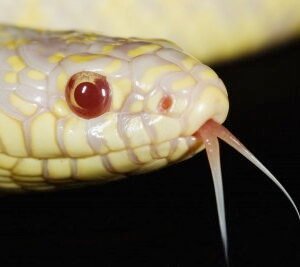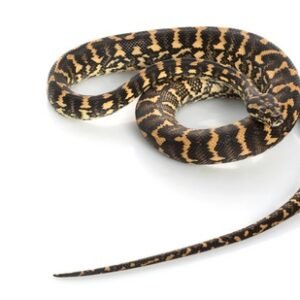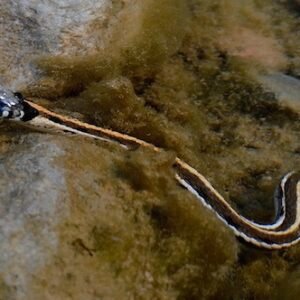The Fascinating Palmetto Corn Snake: A Comprehensive Guide
Introduction to the Palmetto Corn Snake
The Palmetto Corn Snake is a striking morph of the common corn snake (Pantherophis guttatus), renowned for its distinctive physical traits and vibrant coloration. One of the most remarkable aspects of the Palmetto morph is its unique pattern, which often lacks the traditional dark patterns found on typical corn snakes. Instead, the Palmetto showcases an iridescent white to cream base color, accented with pastel yellow, orange, or even pink hues. This stunning combination sets it apart from other corn snake morphs, making it a favorite among reptile enthusiasts and collectors alike.
This morph originated through a genetic mutation that affects the production of pigment in the snake’s scales. Initially discovered in the wild, the Palmetto Corn Snake was bred in captivity to enhance its beautiful colors and increase its availability in the pet trade. The gene responsible for the Palmetto’s unique coloration is a combination of the anerythristic and ultramelanistic traits, leading to its lighter appearance and the absence of typical orange and red shades often seen in other morphs.
In summary, the Palmetto Corn Snake encapsulates a blend of unique visual appeal, scientific intrigue, and friendly disposition, contributing to its growing fame among reptile enthusiasts. As we delve deeper into this comprehensive guide, we will explore its care requirements, habitat, and behavior, further affirming why this morph has become a sought-after choice for snake lovers.
Habitat and Care Requirements
The Palmetto Corn Snake, a beloved pet among reptile enthusiasts, requires a carefully curated habitat to thrive. Understanding the preferred temperature ranges is essential for the overall health of this species. Ideally, the ambient temperature in the enclosure should range from 75°F to 85°F, with a basking area reaching up to 88°F to 90°F. This temperature gradient allows the snake to thermoregulate effectively. Nighttime temperatures can be slightly lower, but should not fall below 70°F.
Humidity is another critical factor in creating a suitable habitat. The Palmetto Corn Snake thrives in a humidity level of approximately 40% to 60%. Maintaining this level is vital, particularly during shedding cycles, as excessive dryness can lead to incomplete sheds and other health issues. To manage humidity, consider utilizing a hygrometer to monitor levels and introduce a shallow water dish, allowing the snake to hydrate as needed.
Enclosure size plays a significant role in providing comfort and security for the Palmetto Corn Snake. A minimum tank size of 20 gallons is recommended for juvenile snakes, and as they grow, upgrading to a larger space of at least 40 gallons is advisable. Utilizing a secure glass terrarium not only ensures visibility for observation but also aids in maintaining optimal temperature gradients.
Substrate choice is just as important as environmental factors. A safe and suitable substrate, such as aspen shavings or coconut fiber, not only provides appropriate bedding but also retains humidity better than other materials. Additionally, incorporating hiding spots, such as caves or plants, is essential for the snake’s psychological wellbeing, allowing it to retreat and feel secure. In terms of dietary needs, a diet consisting primarily of appropriately sized rodents is ideal for a Palmetto Corn Snake. This diet should be adjusted as the snake grows, ensuring regular feeding schedules for consistency in health.
Behavior and Temperament
The Palmetto Corn Snake is widely recognized for its docile and gentle nature, making it an ideal choice for both novice and experienced snake enthusiasts. Their easy-going temperament often allows them to interact with handlers comfortably, promoting a positive relationship between the snake and its owner. Regular handling can help these snakes become accustomed to human interaction, thus reducing stress during routine care.
When handling a Palmetto Corn Snake, it is essential to approach them with a calm demeanor. Gently grasping the snake from the middle of its body, while supporting both its head and tail, is generally recommended. It is crucial to minimize sudden movements and avoid grabbing the snake’s tail, as this can induce stress and discomfort. Typically, these snakes enjoy being handled, especially when they feel secure in their environment.
In captivity, Palmetto Corn Snakes exhibit various typical behaviors. They are primarily nocturnal, meaning they are most active during the evening. An observer may notice them exploring their habitat, frequently climbing on branches or perching on rocks. Providing climbing structures and hiding spots within their enclosure can enrich their lives, as it mimics their natural habitat and satisfies their exploratory instincts.
Recognizing signs of stress or discomfort in Palmetto Corn Snakes is crucial for their well-being. Common indications include hissing, increased hiding, and attempts to escape. Other signs may include rapid tongue flicking or stiffening of the body. Monitoring these behaviors closely can help owners adjust the snake’s environment or handling frequency to ensure its comfort. Creating a stress-free atmosphere promotes a healthy and rewarding experience both for the snake and its handler.
Breeding and Genetics
The breeding of Palmetto Corn Snakes requires a sound understanding of genetics, particularly because the palmetto morph is a captivating example of how genetic combinations can lead to visually stunning reptiles. This morph is the product of the interaction between the anerythristic and motley gene traits, resulting in a striking white and yellow pattern. Therefore, to produce healthy and visually appealing hatchlings, breeders must be aware of these genetic traits and their inheritance patterns.
A key consideration in breeding Palmetto Corn Snakes is maintaining genetic diversity. Inbreeding can lead to various health issues, including weakened immune systems and reduced fertility. Therefore, it is essential to introduce new genetic lines into breeding projects. This approach not only enhances the overall health of the snakes but also increases the likelihood of producing unique morphs, which can be a significant advantage in a competitive market.
Understanding the breeding cycle is crucial for successful reproduction. Corn snakes typically reach sexual maturity between two to three years of age. Breeding usually occurs in the spring, following a period of hibernation to simulate natural conditions. Post-mating, females will lay eggs approximately 30 days later, which can then be incubated at a stable temperature of around 80-85°F. The eggs require consistent humidity, making it imperative for breeders to monitor conditions carefully during the incubation period.
Once hatchlings emerge—usually around 60 days later—it is vital to provide proper care. Newly hatched Palmetto Corn Snakes should be housed in separate enclosures to prevent cannibalism and stress. A diet of appropriately sized prey, typically pinky mice, is essential for their growth and development. By emphasizing responsible breeding and care practices, breeders can ensure the health and well-being of these captivating snakes, fostering a thriving population of Palmetto Corn Snakes that showcases their beauty and genetic richness.

